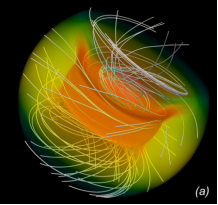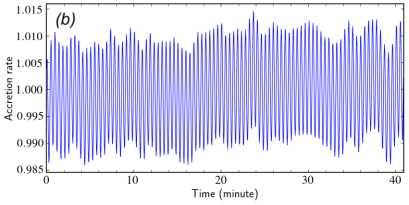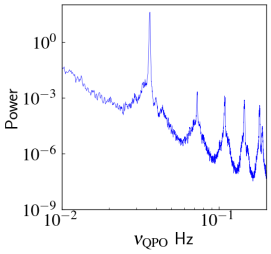Scientists found a new flickering pattern, which provides evidence of a new type of matter falling onto a black hole.
Quasi-periodic oscillations (QPOs) are rhythmic flickers of light emitted from near black holes, like earthquakes revealing Earth's interior; they expose hidden black hole physics. New flickering patterns in light from the surroundings of the supermassive black holes (SMBHs) have been suggested by astrophysicists as proof of a yet unconfirmed kind of flow. Low-angular momentum accretion can produce centi-Hertz (cHz) QPOs—rapid, periodic fluctuations in brightness caused by a resonance near the supermassive black hole—researchers from Tsung-Dao Lee Institute, Shanghai Jiao Tong University, found using state-of-the-art numerical simulations. These cHz QPOs provide an unprecedented observational signature of black holes swallowing matter and interactions with their surroundings. These findings were published recently in The Astrophysical Journal Letters —— Emergence of cHz Quasi-periodic Oscillations from Low Angular Momentum Flow onto a Supermassive Black Hole.


Figure: (a) Formation of PS close to the black hole with GRMHD simulation, and (b) oscillations of the accretion rate at the horizon.
Astrophysicists have revealed a way of studying the extreme environments near SMBHs by identifying a unique pattern of flickering light that may disclose how gas and plasma fall toward these cosmic giants, which are billions to trillions of times more massive than our Sun. Though well-known for swallowing everything that comes close to them, black holes can also flicker and pulse with amazing regularity. This flickering of observed electromagnetic radiations (lights of all wavelengths) is called quasi-periodic oscillations (QPOs)—a pattern of brightening and dimming seen at regular intervals in the light emitted from the extremely hot matter falling onto a black hole known as accretion flow. QPOs occur at specific frequencies and provide a unique way to probe the physics of black holes, much like how seismologists use earthquakes to study Earth’s interior.
QPOs are one of the direct clues we have for studying the black holes. Scientists can infer the properties of spacetime near the event horizon, which is known as the point of no return (even light can escape from it). These oscillations can tell us about the dynamics of accretion, the spin of the black hole, and even test Einstein’s theory of general relativity under extreme conditions. Until now, QPOs observed in recent years from SMBH sources have mostly appeared at milliHertz (mHz) frequencies, meaning the flickering occurs over timescales of minutes to hours. However, this study predicts QPOs at much higher cHz (centi-Hertz) frequencies and beyond, which occur at timescales 10 to 100 times shorter than expected before. This is crucial because it suggests a new, previously debated type of matter flow known as low-angular momentum accretion and its influences on the black hole’s feeding process to make it detectable.
Using cutting-edge general relativistic magnetohydrodynamic (GRMHD) simulations, the research team modeled how matter with low angular momentum falls onto SMBHs. This study shows the formation and the role of the pseudo surface (PS)—a region near the black hole where low-angular momentum matter accumulates before plunging inward. Unlike the event horizon of a traditional black hole, which acts as a one-way boundary where nothing can escape, the PS forms due to the slow radial infall of gas that temporarily piles up before falling in. This region significantly alters the accretion dynamics, creating a feedback mechanism where matter interacts with itself before crossing the event horizon. The interaction at this PS leads to periodic fluctuations in density and pressure, which in turn generate resonant oscillations that appear as cHz QPOs in the light emitted. For the first time, these simulations revealed that such flows can naturally produce cHz QPOs—flickering at much higher frequencies than previously expected. These oscillations occur in a 2:1 harmonic ratio, meaning that if one flicker happens at a given frequency, another follows at exactly double the rate. By linking this with recent observations of Sagittarius A* (the supermassive black hole at our galaxy center) and other active black holes, the study suggests that detecting these high-frequency QPOs in real observations could provide direct evidence of low-angular momentum accretion flows—a missing piece in black hole physics.

Figure: Power of the oscillations showing cHz QPOs.
Dr. Indu K. Dihingia, at Tsung-Dao Lee Institute, Shanghai Jiao Tong University, the lead author and corresponding author said "Our study reveals a previously unseen signature of black hole accretion, shedding light on how matter falls into supermassive black holes in ways we never imagined before." This opens new observational pathways for high-resolution telescopes like the Event Horizon Telescope (EHT), the next-generation Event Horizon Telescope (ngEHT), the James Webb Space Telescope (JWST), and the Very Large Telescope Interferometer GRAVITY instrument (VLTI-GRAVITY) to detect these flickers.
This study transforms our understanding of black hole accretion. The discovery of cHz QPOs suggests that matter doesn’t always spiral in smoothly—it can plunge in more chaotically, interacting at the PS before falling in, leaving a unique fingerprint in the flickering light we see. Prof. Yosuke Mizuno at Tsung-Dao Lee Institute, Shanghai Jiao Tong University, the corresponding author concluded, “If confirmed observationally, this could be a breakthrough in strong-gravity astrophysics and unlocking new mysteries of black holes. As telescopes become more powerful, the search for these flickering signals will push the frontiers of our understanding of the universe’s most enigmatic objects.”
Indu K Dihingia, Yosuke Mizuno “Emergence of cHz Quasi-periodic Oscillations from Low Angular Momentum Flow onto a Supermassive Black Hole”, The Astrophysical Journal Letters, 982, L21.
Dr. Indu K Dihingia
Tsung-Dao Lee Institute
Shanghai Jiao Tong University
ikd4638@sjtu.edu.cn
ikd4638@gmail.com
Prof. Yosuke Mizuno
Tsung-Dao Lee Institute
Shanghai Jiao Tong University
mizuno@sjtu.edu.cn
The National Key R&D Program of China (grant No. 2023YFE0101200), the National Natural Science Foundation of China (grant No. 12273022), and the Shanghai Municipality Orientation Program of Basic Research for International Scientists (grant No. 22JC1410600).

